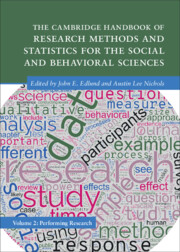 The Cambridge Handbook of Research Methods and Statistics for the Social and Behavioral Sciences
The Cambridge Handbook of Research Methods and Statistics for the Social and Behavioral Sciences from Part II - Important Methodological Considerations
Published online by Cambridge University Press: 12 December 2024
Registered Reports provide one way to address shortcomings in the current way we manage research – from the design of studies to their publication. The format requires pre-specifying (1) why a design may crucially test a theory, (2) what auxiliary assumptions are required for the experiment to be such a test, (3) what outcome-neutral tests are required to test those assumptions, (4) what specific crucial tests will be used to test the theory (of the many tests that could be used), and (5) why those tests could provide evidence for no effect of interest given the proposed numbers of trials and participants. Reviewers and authors are then constructively involved in optimizing the study before it is performed. The agreement between reviewers and authors, as adjudicated by the editors, defines, in advance, the proposed method and analytic protocol, virtually guaranteeing acceptance of the paper, no matter what position, if any, the results support. In this chapter, I go through what problems the format solves and why it must be approached in a way that is little understood by people coming to it for the first time. Common pitfalls are also discussed. In all, the paper provides a roadmap for how readers, authors, and editors can approach Registered Reports.
To save this book to your Kindle, first ensure no-reply@cambridge.org is added to your Approved Personal Document E-mail List under your Personal Document Settings on the Manage Your Content and Devices page of your Amazon account. Then enter the ‘name’ part of your Kindle email address below. Find out more about saving to your Kindle.
Note you can select to save to either the @free.kindle.com or @kindle.com variations. ‘@free.kindle.com’ emails are free but can only be saved to your device when it is connected to wi-fi. ‘@kindle.com’ emails can be delivered even when you are not connected to wi-fi, but note that service fees apply.
Find out more about the Kindle Personal Document Service.
To save content items to your account, please confirm that you agree to abide by our usage policies. If this is the first time you use this feature, you will be asked to authorise Cambridge Core to connect with your account. Find out more about saving content to Dropbox.
To save content items to your account, please confirm that you agree to abide by our usage policies. If this is the first time you use this feature, you will be asked to authorise Cambridge Core to connect with your account. Find out more about saving content to Google Drive.